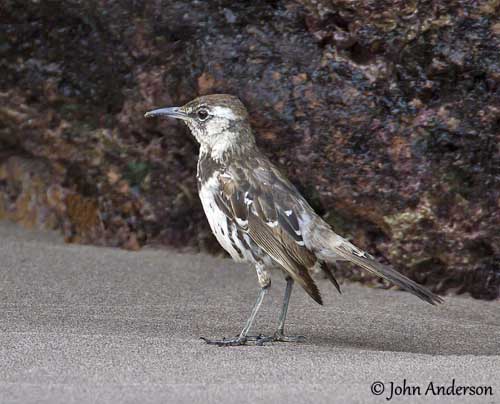
Fr: Moqueur de Floreana
All: Floreanaspottdrossel
Esp: Sinsonte de Floreana – Cucube (Ecuador)
Ita: Mimo delle Galapagos
Nd: Floreanaspotlijster
Sd: Floreanahärmtrast
Photographer:
John Anderson
John Anderson Photo Galleries
Text --byde Nicole Bouglouan
Sources:
HANDBOOK OF THE BIRDS OF THE WORLD Vol 10 by Josep del Hoyo-Andrew Elliott-David Christie - Lynx Edicions - ISBN: 8487334725
WRENS, DIPPERS AND THRASHERS by Brewer David – illustrated by Barry Kent Mackay- Yale University Press - ISBN: 0300090595
BirdLife International (BirdLife International)
Neotropical Birds – Cornell Lab of Ornithology
Floreana Mockingbird
Mimus trifasciatus
Passeriformes Order – Mimidae Family
INTRODUCTION:
The Floreana Mockingbird is also named Charles Mockingbird. It was formerly included in the genus Nesomimus with three other mockingbirds endemic to the Galapagos Islands. These four distinct species probably have a single, ancestral species, maybe the Long-tailed Mockingbird (Mimus longicaudatus).
The Floreana Mockingbird has very restricted range, some few islets adjacent to Floreana. This species was common in Darwin’s time, but it is now Critically Endangered due to extreme weather conditions and introduced predators. The estimated global population mentions less than 300 individuals.
DESCRIPTION OF THE BIRD:
Biometrics:
Length: 25-26 cm
Weight: M: 66 g – F: 60 g
The adult has dark chocolate-brown upperparts including crown, nape, back and rump, with pale edges on most feathers. The wing-coverts are dark brown with white tips, forming two wingbars on closed wings. The blackish-brown flight-feathers show pale edges and broad white tips, especially on secondaries in fresh plumage. The tail is blackish-brown too, with pale tips on outer rectrices.
On the underparts, chin and throat are buffy. On the buffy-white breast, we can see conspicuous dark patches at sides. Large dark spots are visible on the white lower breast, sides of belly and flanks. The vent is white. The underwing is greyish with dark brown markings.
On the dark chocolate-brown head, there is a pale eyeline. Ear-coverts are mottled dark.
The slightly downcurved bill is black and relatively long. The eyes are dark brown. Legs and feet are blackish.
Both sexes are similar, with female slightly smaller than male.
The juvenile resembles adults but it has more streaked plumage.

RANGE:
The Floreana Mockingbird is restricted to two islets, Gardner and Campeón, near Floreana, in S Galapagos Islands.
HABITAT:
The Floreana Mockingbird frequents desert and semi-desert scrub with scattered trees and Opuntia cacti. It can be found in low vegetation on the littoral.
CALLS AND SONGS: SOUNDS BY XENO-CANTO
The Floreana Mockingbird utters long, melodious song, but any mimic of other bird species. The call is a series of short, tiny “tui-tui…tui…tui…”
BEHAVIOUR IN THE WILD:
The Floreana Mockingbird is omnivorous. It feeds mainly on invertebrates and primarily on insects, but its diet may also include cactus fruits and flowers, nectar, berries and carrion such as dead seabirds, lizards and sea lions. It probably takes the eggs of other birds, or at least broken eggs.
It often forages on the ground, but also higher according to the food source.
The Floreana Mockingbird is cooperative breeder. The territory of about 2 ha on average, is defended by the strongly territorial owners. Like all Mimidae species, it is very territorial. The group may include 2 to 10 birds, with one or two breeding pairs.
They have a variety of displays, also used throughout the year and especially while feeding on the ground. Wing-flashing and tail-flashing are the commonest, and are widely used in courtship displays.
These movements enhance wing and tail patterns.
The Floreana Mockingbird is sedentary within its restricted range.
Like numerous island birds, it usually runs rather than flies, at least over short distances, but even over longer ones. Usually reluctant to fly from a disturbance, it escapes to cover by running. In the same way, it prefers to climb for reaching the cactus fruits and flowers, rather than to fly up to the top.
REPRODUCTION OF THIS SPECIES:
The breeding season takes place between October and April.
As cooperative breeder, there are 4-5 adults per group, according to the size of the territory, and usually one breeding female.
The nest is very often placed in cactus, and occasionally in shrub. This is a cup made with twigs and lined with soft materials.
The female lays 2-4 eggs. The young members of the group help the adults to rear the chicks.
The females can breed earlier than males. They disperse from the natal territory, whereas the males usually inherit this area.
PROTECTION / THREATS / STATUS:
The Floreana Mockingbird has very restricted range in the Galapagos Islands. With a population of less than 300 individuals, this species is Critically Endangered.
Nest predation by introduced rats and habitat destruction by goats and other mammals are the main threats in the recent past. The dry La Niña years involved heavy adult mortality too.
This species does not move to Floreana, and has lost a large amount of genetic diversity, making these birds vulnerable to diseases.
The reintroduction of the Floreana Mockingbird to Floreana is part of conservation measures in progress, but only if eradication of introduced predators and species such as rats, cats, anis, pigs, goats and donkeys is successful.